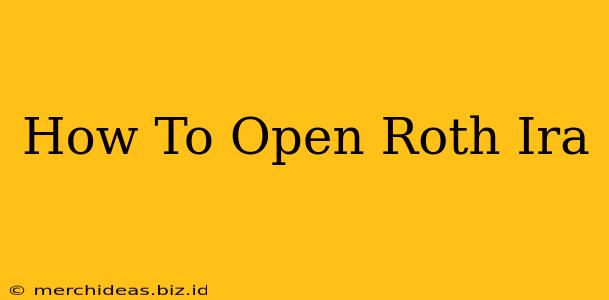Opening a Roth IRA is a crucial step towards securing your financial future. This guide will walk you through the process, helping you understand the requirements and choose the best option for your needs. Understanding how to open a Roth IRA empowers you to take control of your retirement savings and potentially enjoy tax-free withdrawals later in life.
Understanding Roth IRAs
Before diving into the specifics of opening an account, let's quickly review the basics of a Roth IRA. A Roth IRA is a retirement savings account where contributions are made after tax, meaning you've already paid taxes on the money you contribute. However, the significant advantage is that qualified withdrawals in retirement are tax-free. This contrasts with a traditional IRA, where contributions are tax-deductible, but withdrawals are taxed in retirement.
Key benefits of a Roth IRA:
- Tax-free withdrawals in retirement: This is the primary attraction. You'll enjoy your retirement savings without paying any taxes on the withdrawals.
- Potential for tax-free growth: Your investments grow tax-deferred, meaning you won't pay taxes on any investment gains until you withdraw them in retirement.
- Flexibility: You can withdraw your contributions at any time, tax and penalty-free. However, be mindful of early withdrawal penalties for earnings.
Who Should Open a Roth IRA?
A Roth IRA is a great option for many, but it's particularly beneficial for:
- Younger investors: The longer your money has to grow tax-free, the greater the potential benefits.
- Those expecting higher income in the future: Since you pay taxes on contributions now, it can be advantageous if you anticipate being in a higher tax bracket during retirement.
- Anyone wanting tax-free retirement income: The ultimate goal of a Roth IRA is to enjoy tax-free withdrawals.
Steps to Opening a Roth IRA
Opening a Roth IRA is generally straightforward. Here's a step-by-step guide:
1. Choose a Brokerage Firm or Financial Institution
Several institutions offer Roth IRAs, each with varying fees, investment options, and account management tools. Consider factors such as:
- Fees: Look for low or no-fee options to maximize your returns.
- Investment options: Choose a firm offering a range of investment choices that align with your risk tolerance and financial goals. This could include mutual funds, ETFs, individual stocks, and bonds.
- Customer service: Ensure the firm provides adequate customer support and resources.
Popular options include: Fidelity, Schwab, Vanguard, and many banks.
2. Gather Necessary Information
Before you begin the application, you'll need the following information:
- Social Security number: This is crucial for identification and tax purposes.
- Bank account information: You'll need to link your bank account for contributions.
- Employer's information (if applicable): If you're contributing through your employer's plan, you'll need their details.
3. Complete the Application
The application process typically involves filling out an online form or a paper application. You will need to provide all the information mentioned above and indicate the amount you wish to contribute.
4. Fund Your Account
Once your application is approved, you can fund your Roth IRA by transferring funds from your bank account. Remember to contribute within the annual contribution limits set by the IRS.
5. Monitor and Manage Your Investments
Regularly monitor your investment performance and rebalance your portfolio as needed to ensure it aligns with your risk tolerance and goals.
Contribution Limits
It's crucial to stay within the IRS-mandated annual contribution limits. Exceeding these limits can result in penalties. Always check the current limits on the IRS website, as they can change yearly.
Consider Professional Advice
While opening a Roth IRA is relatively simple, it's wise to seek professional financial advice, especially if you have complex financial circumstances or are unsure about the best investment strategy for your needs. A financial advisor can help you navigate the complexities and develop a personalized retirement plan.
By following these steps, you can successfully open a Roth IRA and start building a strong foundation for a secure financial future. Remember, starting early is key to maximizing the benefits of tax-free growth and withdrawals.
